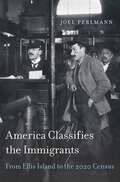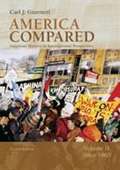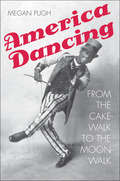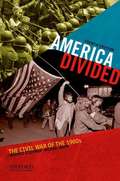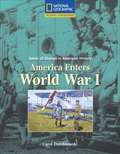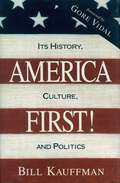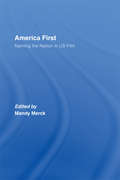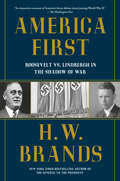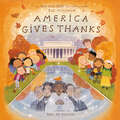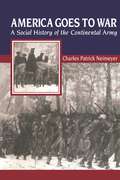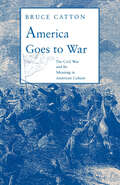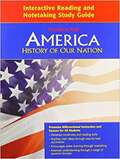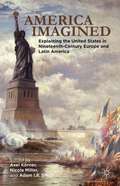- Table View
- List View
America Classifies the Immigrants: From Ellis Island to the 2020 Census
by Joel PerlmannWhen more than twenty million immigrants arrived in the United States between 1880 and 1920, the government attempted to classify them according to prevailing ideas about race and nationality. But this proved hard to do. Ideas about racial or national difference were slippery, contested, and yet consequential—were “Hebrews” a “race,” a “religion,” or a “people”? As Joel Perlmann shows, a self-appointed pair of officials created the government’s 1897 List of Races and Peoples, which shaped exclusionary immigration laws, the wording of the U.S. Census, and federal studies that informed social policy. Its categories served to maintain old divisions and establish new ones. <P><P> Across the five decades ending in the 1920s, American immigration policy built increasingly upon the belief that some groups of immigrants were desirable, others not. Perlmann traces how the debates over this policy institutionalized race distinctions—between whites and nonwhites, but also among whites—in immigration laws that lasted four decades. <P><P> Despite a gradual shift among social scientists from “race” to “ethnic group” after the 1920s, the diffusion of this key concept among government officials and the public remained limited until the end of the 1960s. Taking up dramatic changes to racial and ethnic classification since then, America Classifies the Immigrants concentrates on three crucial reforms to the American Census: the introduction of Hispanic origin and ancestry (1980), the recognition of mixed racial origins (2000), and a rethinking of the connections between race and ethnic group (proposed for 2020).
America Compared: Since 1865 (Second Edition)
by Carl J. GuarneriIdeal for instructors seeking to present U. S. history in a global context, this innovative reader pairs comparative readings on key issues such as slavery, immigration, imperialism, civil rights, and western expansion. Introductions to the selections provide historical context for the issue at hand, background information on the countries being compared, and discussion of ideas or arguments contained in the selections.
America Dancing
by Megan PughThe history of American dance reflects the nation's tangled culture. Dancers from wildly different backgrounds learned, imitated, and stole from one another. Audiences everywhere embraced the result as deeply American. Using the stories of tapper Bill "Bojangles" Robinson, Ginger Rogers and Fred Astaire, ballet and Broadway choreographer Agnes de Mille, choreographer Paul Taylor, and Michael Jackson, Megan Pugh shows how freedom--that nebulous, contested American ideal--emerges as a genre-defining aesthetic. In Pugh's account, ballerinas mingle with slumming thrill-seekers, and hoedowns show up on elite opera house stages. Steps invented by slaves on antebellum plantations captivate the British royalty and the Parisian avant-garde. Dances were better boundary crossers than their dancers, however, and the issues of race and class that haunt everyday life shadow American dance as well. Deftly narrated, America Dancing demonstrates the centrality of dance in American art, life, and identity, taking us to watershed moments when the nation worked out a sense of itself through public movement.
America Divided: The Civil War of the 1960s
by Michael Kazin Maurice IssermanAmerica Divided: The Civil War of the 1960s, Fourth Edition, is the definitive interpretive survey of the political, social, and cultural history of 1960s America. Written by two top experts on the era-Maurice Isserman, a scholar of the Left, and Michael Kazin, a specialist in Right-wing politics and culture-this book provides a compelling tale of this tumultuous era filled with fresh and persuasive insights. For the fourth edition the authors have updated the text in light of new research, offering strong and thoughtful analysis of such key topics as the U. S. entry into the Vietnam War, youth culture, the New Left, and women and minority groups. Presenting the most even-handed overview of this turbulent period, America Divided, Fourth Edition, defines, discusses, and analyzes all sides of the political, social, and cultural conflicts of the 1960s in a swiftly moving narrative. It is ideal for courses in 1960s America and America since 1945, or for anyone interested in the last fifty years of American History.
America Dreaming: How Youth Changed America in the Sixties
by Laban Carrick HillLaban Hill, author of the acclaimed Harlem Stomp, is back with an in-depth exploration of America in the 1960's and the young people who built a new world around them and changed our society significantly. Like Harlem Stomp, America Dreaming is an educational and visual look into a time of energy and influence. Covering subjects such as the civil rights movement, hippie culture, black nationalism, and the feminist movement, Hill paints a sprawling picture of life in the '60's and shows how teenagers were on the forefront of the societal changes that occurred during this grand decade. America Dreaming is a virtual time capsule, full of photos, song lyrics, poetry, art, protest posters, sixties lingo and iconography that will give readers an authentic and inspiring experience.
America Enters World War I
by Carol DomblewskiThe book talks about the World War I's two main alliances,how nations began to build strong armies,navies, to train soldiers , make weapons and how America entered the war.
America First!: Its History, Culture, and Politics
by Bill KauffmanAmerica First! is a rarity among political books: first published in 1995, it remains more timely, relevant, and even urgent than ever. Lively and iconoclastic, it explores the rich heritage, the turbulent present, and the possible future of the political and cultural tendency known as "America First." Bill Kauffman, a columnist for the American Conservative, examines the nineteenth-century underpinnings and twentieth-century eruptions of American isolationism and nationalism, which are the fault lines along which the politics of the twenty-first century are cleaving. In a new preface and epilogue written especially for this reissue, he traces the evolution of America First sentiment over the past twenty years: from its near-eclipse in the war hysteria of the George W. Bush administration to its revival in 2016 with the populist campaigns of Donald Trump and Senator Bernie Sanders.
America First: Naming the Nation in US Film
by Mandy MerckAt a time when the expanded projection of US political, military, economic and cultural power draws intensified global concern, understanding how that country understands itself seems more important than ever. This collection of new critical essays tackles this old problem in a new way, by examining some of the hundreds of US films that announce themselves as titularly 'American'. From early travelogues to contemporary comedies, national nomination has been an abiding characteristic of American motion pictures, heading the work of Porter, Guy-Blaché, DeMille, Capra, Sternberg, Vidor, Minnelli and Mankiewicz. More recently, George Lucas, Paul Schrader, John Landis and Edward James Olmos have made their own contributions to Hollywood’s Americana. What does this national branding signify? Which versions of Americanism are valorized, and which marginalized or excluded? Out of which social and historical contexts do they emerge, and for and by whom are they constructed? Edited by Mandy Merck, the collection contains detailed analyses of such films as The Vanishing American, American Madness, An American in Paris, American Graffiti, American Gigolo, American Pie and many more.
America First: Roosevelt vs. Lindbergh in the Shadow of War
by H. W. BrandsBestselling historian and Pulitzer Prize finalist H. W. Brands narrates the fierce debate over America's role in the world in the runup to World War II through its two most important figures: President Franklin D. Roosevelt, who advocated intervention, and his isolationist nemesis, aviator and popular hero Charles Lindbergh.&“An immersive account of America&’s fierce debate about joining World War II.&” — The Washington Post"Brands&’s elegant account of the political faceoff between Franklin Roosevelt and Charles Lindbergh could not be more timely." — Charles A. Kupchan, author of Isolationism: A History of America&’s Efforts to Shield Itself from the WorldHitler's invasion of Poland in September 1939 launched a momentous period of decision-making for the United States. With fascism rampant abroad, should America take responsibility for its defeat?For popular hero Charles Lindbergh, saying no to another world war only twenty years after the first was the obvious answer. Lindbergh had become famous and adored around the world after his historic first flight over the Atlantic in 1927. In the years since, he had emerged as a vocal critic of American involvement overseas, rallying Americans against foreign war as the leading spokesman the America First Committee. While Hitler advanced across Europe and threatened the British Isles, President Franklin Delano Roosevelt struggled to turn the tide of public opinion. With great effort, political shrewdness and outright deception—aided by secret British disinformation efforts in America—FDR readied the country for war. He pushed the US onto the world stage where it has stayed ever since.In this gripping narrative, H.W. Brands sheds light on a crucial tipping point in American history and depicts the making of a legendary president.
America Gives Thanks
by Bob McKinnonIn this stand-alone companion to America&’s Dreaming, New York Times bestselling author Bob McKinnon and celebrated illustrator Thai My Phuong craft a beautiful, sweeping story about the importance of speaking up for what really matters.Have you ever wondered why people complain so much?America is very excited for their class&’s upcoming field trip to Washington, DC. But when the other kids start complaining about how not excited they are, America is confused. Their teacher, Mr. Downs, uses this as a learning opportunity: sometimes complaining—when done right—can actually be useful.As the class walks through historic halls like the Supreme Court and around the National Mall where they visit celebrated monuments like the Lincoln Memorial, historical figures come alive for America (that portrait of Ruth Bader Ginsburg is definitely winking). Each figure offers tales on how complaining can lead to long-lasting change and hope for a better world. For that, America is so thankful.
America Goes to War: A Social History of the Continental Army (The American Social Experience #26)
by Charles Patrick NeimeyerA unique and revealing analysis of the diverse body that made up the Continental Army during the American Revolutionary War.One of the images Americans hold most dear is that of the drum-beating, fire-eating Yankee Doodle Dandy rebel, overpowering his British adversaries through sheer grit and determination. The myth of the classless, independence-minded farmer or hard-working artisan-turned-soldier is deeply ingrained in the national psyche.Charles Neimeyer here separates fact from fiction, revealing for the first time who really served in the army during the Revolution and why. His conclusions are startling. Because the army relied primarily on those not connected to the new American aristocracy, the African Americans, Irish, Germans, Native Americans, laborers-for-hire, and “free white men on the move” who served in the army were only rarely altruistic patriots driven by a vision of liberty and national unity.Bringing to light the true composition of the enlisted ranks, the relationships of African-Americans and of Native Americans to the army, and numerous acts of mutiny, desertion, and resistance against officers and government, Charles Patrick Neimeyer here provides the first comprehensive and historically accurate portrait of the Continental soldier.
America Goes to War: The Civil War and Its Meaning in American Culture
by Bruce CattonA fascinating study of the first modern war and its effect on American Culture.
America Goes to the Fair: All about State and County Fairs in the United States
by Lila PerlCommercial fairs come in all sizes-- county, state, and international--and they are as popular today as ever. How did they come to be? What goes on at them? Why do they continue to appeal to young people? This lively report on the modern fair answers these questions and many others. The opening chapters relate the change from the European market fair, like the one at Nizhni Novgorod in Russia, to the competitive showcase that developed in the United States. Following chapters take up the various activities that fairs engage in: agricultural events, household arts, youth and vocational programs, entertainment, and special exhibits in such fields as science and transportation. Specific examples from the over 3200 fairs that take place each year illustrate each category, and major fairs all over the country are included. Not surprisingly, the largest one is the State Fair of Texas, held outside of Dallas. All this wide-ranging information is gathered together in a smoothly knit narrative by a knowledgeable author, who has participated in a number of fairs herself.
America History of Our Nation: Interactive Reading And Note Taking Study Guide [on-level]
by Prentice-Hall StaffThis edition was developed specifically for courses covering up to the Civil War or Reconstruction. The text can also be used for the first part of a two-year American history course.
America I AM BlACK FACTS: The Timelines Of African American History, 1601-2008
by Quintard TaylorThis invaluable reference timeline charts African American history from 1601-2008 against the backdrop of American and world history. AIA Black Facts reveals the unexpected relationships between people and events, and the often unrecognized causes and effects that created African Americans’ indelible imprint on our nation.
America I am legends: Rare Moments And Inspiring Words
by Tavis SmileyWould America have been America without her Negro people?" - W. E. B. Du Bois America I AM: The African American Imprint, a national traveling museum exhibition, was conceived by award-winning broadcaster and bestselling author Tavis Smiley as a one-of-a-kind multi-media experience that chronicles the distinct history of African Americans. This beautifully conceived companion volume addresses the central theme of the exhibition, posed by W. E. B. Du Bois: "Would America have been America without her Negro people?" Through exceptional photographic images and penetrating words, America I AM Legends captures the dynamism of 78 legendary African Americans, highlighting the indelible imprint each has made on the United States and the world. A statement illuminating a unique aspect of each iconic figure- made by the legend or by someone carrying on their legacy today-portrays the vision and contribution of each subject. Whether black artistic genius, athletic excellence, political leadership, or the struggle to hold America true to its promise, each legend reminds us that America would be unrecognizable without its African American imprint. America I AM Legends takes us on an unforgettable journey to the heart of the American experience.
America Imagined
by Axel K�rner Nicola Miller Adam I. P. SmithThis is an exploration of how Latin America developed an alternative modernity during the early twentieth century, one that challenges the key assumptions of the Western dominant model.
America In The 1970s (Decades Of American History)
by Bree BurnsDesigned to be accessible to young readers, these volumes offer a way of learning about the history of America. Each book includes information on what was happening in the arts, sciences, popular culture, fashion, and music. They include 100 or more photographs, box features, pull-out quotations, a glossary, a further reading list, and an index.
America In The 1990s (Decades Of American History)
by George OchoaDesigned to be accessible to young readers, these volumes offer a way of learning about the history of America. Each book includes information on what was happening in the arts, sciences, popular culture, fashion, and music. They include 100 or more photographs, box features, pull-out quotations, a glossary, a further reading list, and an index.
America In The Time Of Abraham Lincoln: 1815 to 1869
by Sally Senzell IsaacsUses the life of Abraham Lincoln as a reference to examine the history of the United States from 1815 to 1869.
America In the 1900s and 1910s (Decades of American History)
by Jim CallanExplores cultural, economic, and political events of the first two decades of the twentieth century.
America In the 1930s (Decades of American History)
by Jim CallanDesigned to be accessible to young readers, these volumes offer a way of learning about the history of America. Each book includes information on what was happening in the arts, sciences, popular culture, fashion, and music. They include 100 or more photographs, box features, pull-out quotations, a glossary, a further reading list, and an index.
America In the 1960s (Decades of American History)
by Jim CallanDesigned to be accessible to young readers, these volumes offer a way of learning about the history of America. Each book includes information on what was happening in the arts, sciences, popular culture, fashion, and music. They include 100 or more photographs, box features, pull-out quotations, a glossary, a further reading list, and an index.
America Inc.?: Innovation and Enterprise in the National Security State
by Linda WeissFor more than half a century, the United States has led the world in developing major technologies that drive the modern economy and underpin its prosperity. In America, Inc., Linda Weiss attributes the U.S. capacity for transformative innovation to the strength of its national security state, a complex of agencies, programs, and hybrid arrangements that has developed around the institution of permanent defense preparedness and the pursuit of technological supremacy. She examines how that complex emerged and how it has evolved in response to changing geopolitical threats and domestic political constraints, from the Cold War period to the post-9/11 era.Weiss focuses on state-funded venture capital funds, new forms of technology procurement by defense and security-related agencies, and innovation in robotics, nanotechnology, and renewable energy since the 1980s. Weiss argues that the national security state has been the crucible for breakthrough innovations, a catalyst for entrepreneurship and the formation of new firms, and a collaborative network coordinator for private-sector initiatives. Her book appraises persistent myths about the military-commercial relationship at the core of the National Security State. Weiss also discusses the implications for understanding U.S. capitalism, the American state, and the future of American primacy as financialized corporations curtail investment in manufacturing and innovation.
America Invulnerable: The Quest for Absolute Security from 1812 to Star Wars
by James Chace Caleb CarrSurvey of our foreign policy through the 1980's.
